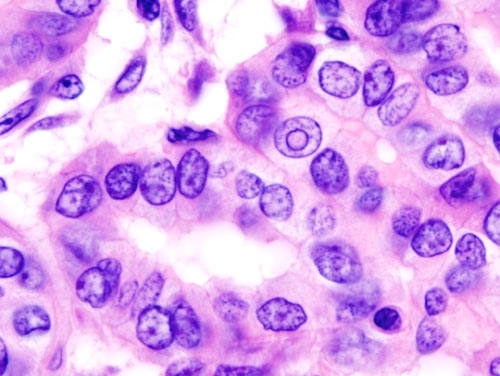

Research shows that expression of 52 microRNAs falls as the disease becomes more aggressive. Restoring levels of these molecules in the tumor could be a novel therapeutic strategy (image: Wikimedia Commons)
Research shows that expression of 52 microRNAs falls as the disease becomes more aggressive. Restoring levels of these molecules in the tumor could be a novel therapeutic strategy.
Research shows that expression of 52 microRNAs falls as the disease becomes more aggressive. Restoring levels of these molecules in the tumor could be a novel therapeutic strategy.

Research shows that expression of 52 microRNAs falls as the disease becomes more aggressive. Restoring levels of these molecules in the tumor could be a novel therapeutic strategy (image: Wikimedia Commons)
By Karina Toledo | Agência FAPESP – Thyroid cancer is a disease with good cure rates in most cases. In 5% of patients, however, the tumor becomes refractory to the available therapies and may spread all over the body, causing death.
In a study conducted at the University of São Paulo’s Biomedical Science Institute (ICB-USP) in Brazil, researchers discovered that increasing tumor aggressiveness is accompanied by decreasing expression of 52 microRNAs – small RNA molecules that do not code for proteins but perform a regulatory function in several cellular processes.
The investigation was performed during the postdoctoral research of Murilo Vieira Geraldo, with support from FAPESP and supervision by Edna Teruko Kimura, a professor at ICB-USP.
The results were published in an article in the journal Oncotarget.
“The data obtained so far suggest these microRNAs can be explored as tumor suppressors. The idea would be to restore normal levels of these molecules in the tumor and see whether this prevents progression of the disease,” said Geraldo, currently a professor at the University of Campinas’s Biology Institute (IB-UNICAMP).
Most of the experiments in his postdoctoral research used a genetically modified (GM) mouse model, he recalled, in which the BRAF gene is silenced only in the thyroid. The alteration is similar to that found in many patients with thyroid cancer or melanoma.
“When this mutation is present, the cancer is usually more aggressive,” he said. “In the case of mice, only five months after birth, they already have a large tumor with the typical papillary tissue architecture. The model mimics what happens in these 5% of patients who die owing to progression of the disease.”
The first step was to evaluate how microRNA expression in general changed as the disease progressed in the GM mice. Next the scientists identified a group of molecules with highly similar behavior, consisting of substantial expression in younger mice with less aggressive tumors and lower expression in more advanced cases.
The scientists then set out to locate the genome region in which these microRNAs were encoded and discovered that it was a location known as the long arm of chromosome 14 (chromosome band 14q32).
“By coincidence, an article published in 2015 revealed the existence of a rare condition called Temple syndrome, characterized precisely by partial or total loss of this genome region,” Geraldo said. “Our study pointed to an increased risk of thyroid cancer in bearers of this syndrome. This reinforced our suspicion that this genome region contains something important to thyroid function.”
The next step was to evaluate expression of these microRNAs in patients with thyroid tumors. This was done using bioinformatics tools in public databases that store genome data for people with thyroid cancer, such as The Cancer Genome Atlas (TCGA). Helder Nakaya, a professor at the University of São Paulo’s School of Pharmaceutical Sciences (FCF-USP), collaborated with this part of the project.
Data for 500 patients collected via the internet confirmed that the expression of these microRNAs was also lower in human tumors.
“When we looked for the targets of these microRNAs, the RNA molecules with which they interact, we found that many of them regulate processes important for the progression of the cancer and metastatic dissemination, such as cell migration and adhesion.”
Validation
The ICB-USP group quasi-randomly selected one of the 52 microRNAs identified in the animal model, miR-654, to validate its function in laboratory tests using human thyroid tumor cell lines.
The in vitro tests confirmed that when expression of miR-654, which was low in the tumor cell lines, was restored to levels equivalent to those of a healthy condition, the cells proliferated less and became less capable of migrating, and more of them died.
In a new project now getting under way at UNICAMP, Geraldo plans to find out which of the 52 microRNAs are most interesting to study in greater detail and worth testing as therapeutic targets.
According to Brazil’s National Cancer Institute (INCA), thyroid cancer is the most common form of head and neck cancer and is three times more frequent in women. Data from the public database Surveillance, Epidemiology & End Results (SEER), owned by the National Cancer Institute (NCI) in the United States, show that the incidence of thyroid cancer has tripled in the last 35 years. Papillary thyroid cancer is the most common subtype, accounting for between 75% and 80% of cases.
The article “Down-regulation of 14q32-encoded miRNAs and tumor suppressor role for miR-654-3p in papillary thyroid cancer” can be read at: oncotarget.com/index.php?journal=oncotarget&page=article&op=view&path[]=14162&pubmed-linkout=1.
Republish
The Agency FAPESP licenses news via Creative Commons (CC-BY-NC-ND) so that they can be republished free of charge and in a simple way by other digital or printed vehicles. Agência FAPESP must be credited as the source of the content being republished and the name of the reporter (if any) must be attributed. Using the HMTL button below allows compliance with these rules, detailed in Digital Republishing Policy FAPESP.





